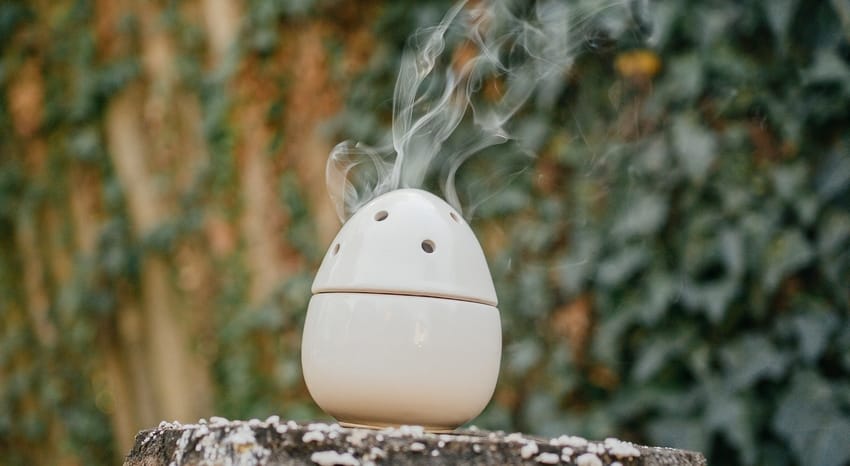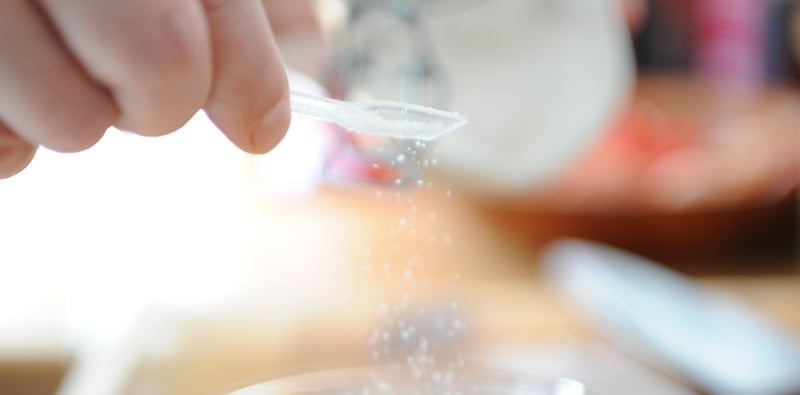Last Updated on January 2, 2024
Unlike most humidifiers that produce mist by vibration, warm mist humidifiers are a less common type that expel water to air in the form of steam. Normally, you will clearly notice this steam coming out of humidifier outlet. But can you make your warm mist humidifier or vaporizer steam more? How to increase steam from humidifier if it has reduced with time?
Increasing minerals in water is the easiest way to make your humidifier steam more. You can do this by adding a pinch or two of salt in humidifier water, or use tap water or suitable amounts of it in distilled water. Demineralization of heating element can also increase humidifier steam by improving current conduction.
These days term ‘vaporizer’ is used interchangeably with ‘warm mist humidifier’, as both these appliances use heating element to boil water to produce steam.

The rate at which your humidifier or vaporizer produces steam has a lot to do with the ability of its heating element to produce electric current and conduct it through water.
In this article I plan to discuss the following:
- Ways to increase steam from humidifier or vaporizer.
- Restoring steam expulsion rate of humidifier after it has reduced over time.
- Properly using tips and techniques to prevent excessive boiling and damage.
How to Make Your Humidifier Steam More?
There are two basic components that are required for your warm mist humidifier or vaporizer to steam; water and heating element.
If you maintain humidifier electrodes and use adequate quality water in it, you will get sufficiently higher amount of steam.
Doing this will also effectively restore steam production rate of your humidifier if it has reduced over time.
1. Use Suitably Hard Water in Your Humidifier
One of the common reasons why your humidifier does not generate enough, or any steam for that matter, is the mineral content of water you are using in it.
If water is very soft, meaning it has very low mineral content, heating element of humidifier will not be able to conduct electricity through the water properly.
The solution is simple, use harder water in your humidifier that has relatively higher amount of minerals.
Start using tap water in your humidifier instead of distilled water. In this way, with sufficient amount of minerals in water, conduction of current will improve. This will lead to boiling of water and eventually steaming.
Note: Be careful with hardness of tap water you use in your humidifier. If tap water is very hard, it will cause excessive boiling and may cause damage by spilling.
You can resolve this problem by mixing suitable amount of tap water with distilled water. This way if water is very hard in your area, you will get just the right amount of minerals in your humidifier required for steaming.
2. Remove Hard Water Scaling on Heating Element
As a side effect of using hard water repeatedly in your warm mist humidifier, a thick layer of minerals will deposit on its heating element. This layer will act as an insulation in between electrodes and water in humidifier reservoir.
Resultantly, flow of electric current through water will be inadequate and it will not boil properly. This ultimately will prevent your humidifier unit from steaming sufficiently.
Well, is there a way to get rid of this mineral scaling on heating electrodes of your warm mist humidifier or vaporizer?
Yes, there is. In fact, there are multiple ways to do this:
First method is to open up your warm mist humidifier or vaporizer, extract the heating element and remove hard water scales by applying pressure and breaking it away into fragments.
This method can damage heating element, especially if you have very hard water in your area and doing this is not a one-time thing.
Second method is to add softening additives to water in humidifier reservoir. Then when mineral deposits on heating electrodes break away, you may remove water entirely and refresh it with a new batch.
This way you can get rid of scaling on heating element multiple times without damaging it. For this purpose, you can use a mixture like vinegar and water.
However, after some research, I found a product designed just for this purpose. Add about 2 teaspoons of BestAir 3US Ultra-Treat Water Treatment to every gallon of water and it will help keep your humidifier heating rods from hard water deposits.
Even if scaling still develops on electrodes due to very hard water, it would be much easier to remove.
3. Adding Minerals to Water Yourself
If water is too soft for your humidifier to steam, there is another way to increase minerals in it:
Add minerals to water yourself.
Most manufacturers prescribe adding salt for this purpose. A few also allow using baking soda.
The goal is same though, increase electrical conduction through water to increase boiling and resultantly make humidifier steam more.
If you use this method to increase steam from your humidifier, start with only a pinch of salt and test it first. Then you can minutely add more afterwards if it is not enough.
Just to give you an idea of scale, a pinch is about 1/16 of a teaspoon. Usually, a little will do.
Higher quantities of salt will cause excessive boiling of water that may lead to spilling and damage. It can also result in electrical failures like blown fuse and breaker turning off.
Note: There is a difference between mist from cold mist humidifier and steam from warm mist humidifier. Never add salt or use any other ways to increase minerals in water of cold mist humidifier. This will result in scaling on its components and white dust in your home, with no effect on mist rate.
These advices and instructions above are exclusive for warm mist humidifier and vaporizer only.

What To Do If No Steam Is Coming Out of Humidifier?
If your humidifier is not producing any steam, it could be one of these problems:
- Heating electrodes are covered with hard water scaling (most common).
- Water is excessively deficient in minerals.
- Heating element is not working.
Warm mist humidifiers and vaporizers are not complex appliances. Diagnosing them is easy.
i) If no steam is coming out of humidifier’s outlet, I would start diagnosing with problem # 2 i.e., mineral deficiency.
Use tap water instead of distilled water. However, if you are already using tap water, use these methods I discussed above to increase minerals in it.
ii) If that does not initiate steaming, next look for mineral deposits on heating element (problem # 1).
Scaling on heating rods is very common when using hard water in routine. Use techniques and products mentioned in this section to get rid of this scaling.
iii) Last and a less likely but possible problem preventing your humidifier or vaporizer to produce steam is defective heating element.
If first two solutions fail, this is likely preventing water in your humidifier to boil and steam.
Heating element can be repaired or replaced. However, I would advise you to just buy a new unit. Usually this is most logical when comparing expenditure on repair and price of humidifier.
How Long Does it take for a Humidifier to Steam?
It is a good idea to know expected time for a humidifier to start steaming. May be all your humidifier needs is a little time for water to boil and steam.
Most specialists say that a warm mist humidifier or vaporizer should take about 10-15 minutes to steam. Some say it should do so in as low as 5 minutes.
Based on this information, it could take your humidifier somewhere from 5-15 minutes to start producing steam. I would recommend you to wait at least till upper limit before diagnosing and taking any actions discussed above.



